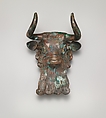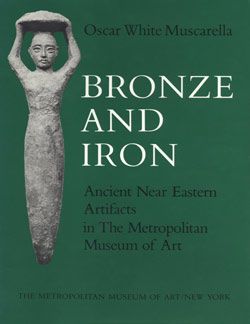Bull's head ornament for a lyre
Not on view
This bull’s head, an object most likely made for attachment to a lyre, was cast in one solid piece. Its skilled craftsmanship complements the rich materials used in its manufacture, including pupils inlaid with lapis lazuli imported from northeastern Afghanistan. Wavy ridges ending in curls delineate the bull’s beard, while the hair locks at the top of the head are perhaps worn smooth by long use. Above the eyes, stacked folds suggest wrinkled skin and highlight the expressiveness of the animal’s gaze. A ridge across the bull’s nose may represent a strap, indicating the animal is shown wearing a false, ceremonial beard.
Lyres with bovine heads of gold, silver, or bronze affixed to the front of the sound box have been found at several sites in Mesopotamia in contexts dating to the third millennium B.C. Most famous are the eight bull-headed lyres from six burials in the Royal Cemetery at Ur. Together with percussion and wind instruments, lyres were used to play royal and divine songs of praise, to accompany conquering armies, and for private amusement. It has been suggested that lyres with bull’s head attachments may have had a deep tone, in keeping with the low tones of bovine vocalizations.
This image cannot be enlarged, viewed at full screen, or downloaded.


